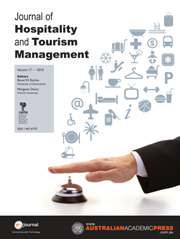Crossref Citations
This article has been cited by the following publications. This list is generated based on data provided by
Crossref.
Schweinsberg, Stephen
Wearing, Stephen L.
and
McManus, Phil
2013.
Exploring sustainable tourism education in business schools: The honours program.
Journal of Hospitality and Tourism Management,
Vol. 20,
Issue. ,
p.
53.
Andersson, Tommy D.
and
Lundberg, Erik
2013.
Commensurability and sustainability: Triple impact assessments of a tourism event.
Tourism Management,
Vol. 37,
Issue. ,
p.
99.
Dahles, Heidi
and
Susilowati, Titi Prabawa
2015.
Business resilience in times of growth and crisis.
Annals of Tourism Research,
Vol. 51,
Issue. ,
p.
34.
Laeis, Gabriel C.M.
and
Lemke, Stefanie
2016.
Social entrepreneurship in tourism: applying sustainable livelihoods approaches.
International Journal of Contemporary Hospitality Management,
Vol. 28,
Issue. 6,
p.
1076.
Huang, Tai
Xi, Jian-chao
and
Ge, Quan-sheng
2017.
Livelihood differentiation between two villages in Yesanpo Tourism District in China.
Journal of Mountain Science,
Vol. 14,
Issue. 11,
p.
2359.
Xue, Lan
and
Kerstetter, Deborah
2019.
Rural Tourism and Livelihood Change: An Emic Perspective.
Journal of Hospitality & Tourism Research,
Vol. 43,
Issue. 3,
p.
416.
Jo, Jang-Hwan
Roh, Taewoo
Shin, Seunguk
and
Youn, Yeo-Chang
2019.
Sustainable Assets and Strategies Affecting the Forestry Household Income: Empirical Evidence from South Korea.
Sustainability,
Vol. 11,
Issue. 13,
p.
3680.
Michler, L.M.
Treydte, A.C.
Hayat, H.
and
Lemke, S.
2019.
Marginalised herders: Social dynamics and natural resource use in the fragile environment of the Richtersveld National Park, South Africa.
Environmental Development,
Vol. 29,
Issue. ,
p.
29.
Su, Zhen
Aaron, Joshua R.
Guan, Yang
and
Wang, Hongchen
2019.
Sustainable Livelihood Capital and Strategy in Rural Tourism Households: A Seasonality Perspective.
Sustainability,
Vol. 11,
Issue. 18,
p.
4833.
Yu, Peng
Zhang, Jinhe
Wang, Yaru
Wang, Chang
and
Zhang, Hongmei
2020.
Can tourism development enhance livelihood capitals of rural households? Evidence from Huangshan National Park adjacent communities, China.
Science of The Total Environment,
Vol. 748,
Issue. ,
p.
141099.
Agyeman, Yaw Boakye
2020.
Handbook of Climate Change Resilience.
p.
537.
Liu-Lastres, Bingjie
Mariska, Dini
Tan, Xiaoyuan
and
Ying, Tianyu
2020.
Can post-disaster tourism development improve destination livelihoods? A case study of Aceh, Indonesia.
Journal of Destination Marketing & Management,
Vol. 18,
Issue. ,
p.
100510.
Gohori, Owen
and
van der Merwe, Peet
2020.
Towards a Tourism and Community-Development Framework: An African Perspective.
Sustainability,
Vol. 12,
Issue. 13,
p.
5305.
Shoeb-Ur-Rahman, Muhammad
Simmons, David G.
Shone, Michael
and
Ratna, Nazmun
2020.
Co-management of Capitals for Community Wellbeing and Sustainable Tourism Development: A Conceptual Framework.
Tourism Planning & Development,
Vol. 17,
Issue. 2,
p.
225.
Li, Huiqin
Guo, Tinghong
Nijkamp, Peter
Xie, Xuelian
and
Liu, Jingjing
2020.
Farmers’ Livelihood Adaptability in Rural Tourism Destinations: An Evaluation Study of Rural Revitalization in China.
Sustainability,
Vol. 12,
Issue. 22,
p.
9544.
Franco, Isabel B.
and
Minnery, John
2020.
Actioning the Global Goals for Local Impact.
p.
5.
Peng, Wanting
López-Carr, David
Wu, Chengzhao
Wang, Xin
and
Longcore, Travis
2020.
What factors influence the willingness of protected area communities to relocate? China's ecological relocation policy for Dashanbao Protected Area.
Science of The Total Environment,
Vol. 727,
Issue. ,
p.
138364.
Nowreen, Samshad
and
Mohiuddin, Md.
2021.
Tourism in Bangladesh: Investment and Development Perspectives.
p.
383.
Matiku, Susan Mbithe
Zuwarimwe, Jethro
and
Tshipala, Ndivhuwo
2021.
Sustainable tourism planning and management for sustainable livelihoods.
Development Southern Africa,
Vol. 38,
Issue. 4,
p.
524.
Phi, Giang Thi
2021.
Handbook of Research on the Role of Tourism in Achieving Sustainable Development Goals.
p.
20.




